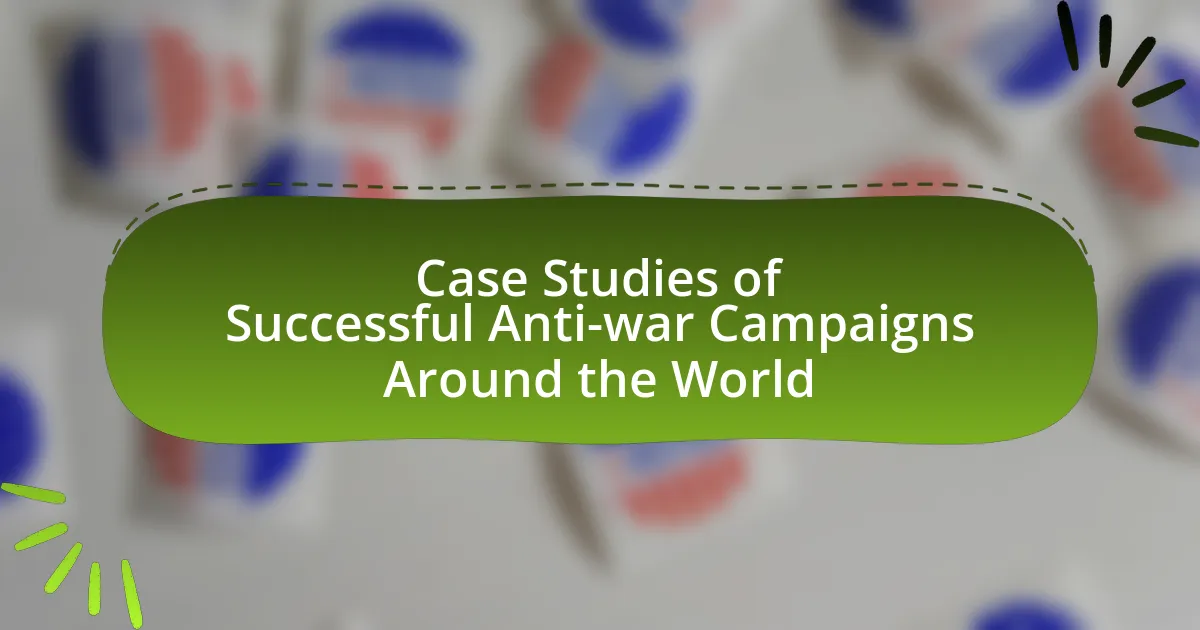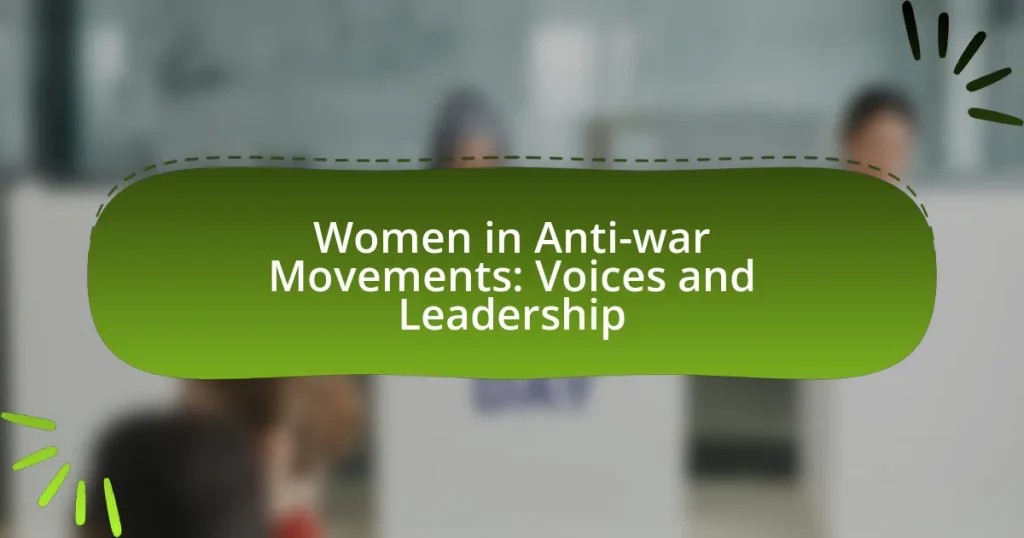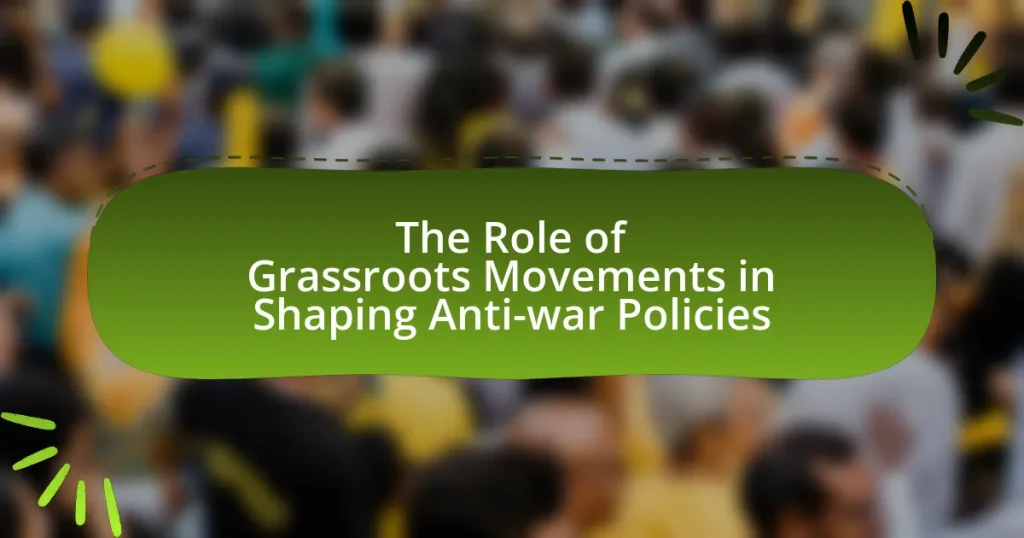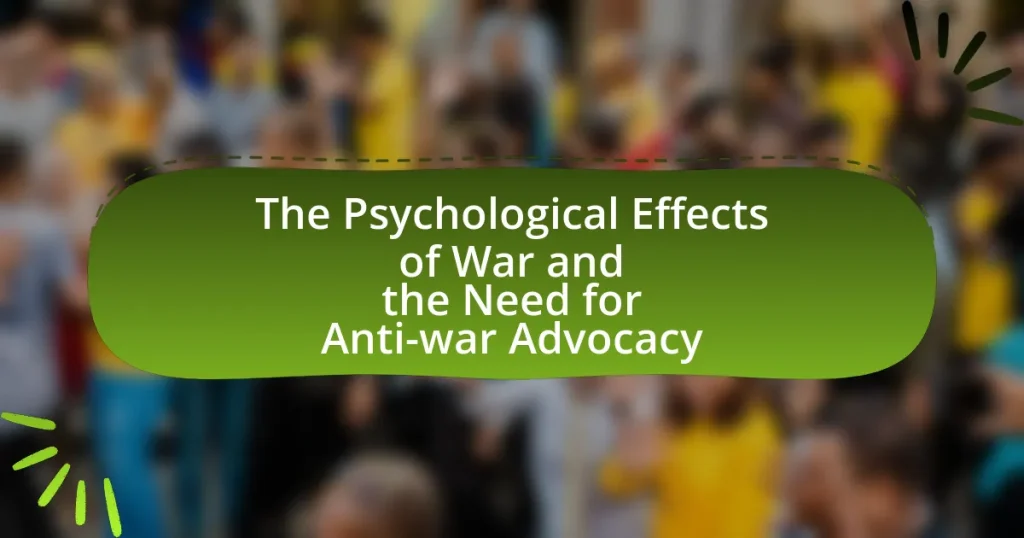Anti-war campaigns are organized efforts aimed at opposing military conflict and advocating for peace through diplomatic solutions. This article examines notable case studies of successful anti-war campaigns worldwide, including the Vietnam War protests and the anti-apartheid movement in South Africa, highlighting their impact on public opinion and policy changes. It explores the methods used by these campaigns to communicate their messages, the influence of cultural factors, and the role of grassroots organizing and coalition-building in enhancing their effectiveness. Additionally, the article addresses the challenges faced by contemporary anti-war movements and the importance of education and awareness in mobilizing support.
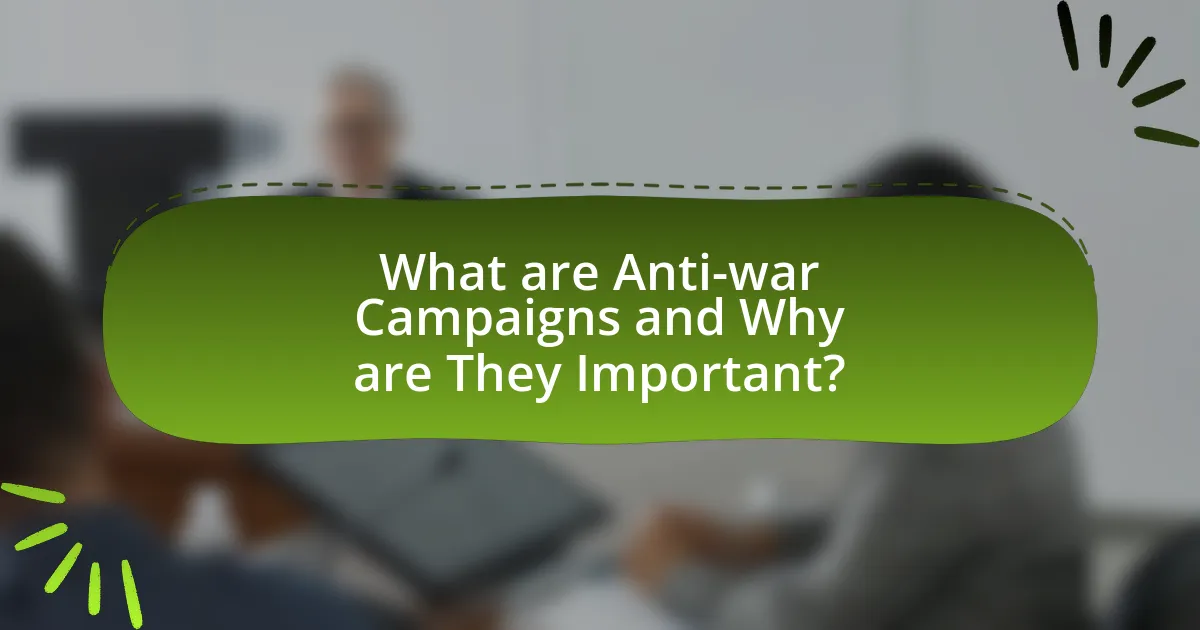
What are Anti-war Campaigns and Why are They Important?
Anti-war campaigns are organized efforts aimed at opposing and preventing military conflict, advocating for peace, and promoting diplomatic solutions. These campaigns are important because they mobilize public opinion, influence policymakers, and can lead to significant changes in government policies regarding war. Historical examples, such as the Vietnam War protests in the 1960s, demonstrate that widespread anti-war sentiment can lead to a reduction in military engagement and a shift towards negotiation and peace-building efforts.
How do Anti-war Campaigns influence public opinion?
Anti-war campaigns significantly influence public opinion by raising awareness about the consequences of war and mobilizing grassroots activism. These campaigns often utilize various media platforms to disseminate information, challenge government narratives, and foster public discourse. For instance, the Vietnam War protests in the 1960s and 1970s effectively shifted public sentiment against the war, as evidenced by a Gallup poll in 1971 showing that 61% of Americans opposed U.S. involvement in Vietnam. This shift was largely attributed to the efforts of anti-war organizations that highlighted the human cost of the conflict through graphic imagery and personal testimonies. Additionally, contemporary movements, such as those opposing the Iraq War, have similarly demonstrated the power of organized protests and social media in shaping public perceptions and influencing political decisions.
What methods do these campaigns use to communicate their message?
Anti-war campaigns communicate their message through various methods, including social media, public demonstrations, and targeted advertising. Social media platforms allow campaigns to reach a wide audience quickly, facilitating the sharing of information and mobilization of supporters. Public demonstrations serve as a visual representation of dissent, drawing media attention and public interest. Targeted advertising, often utilizing data analytics, helps campaigns to effectively reach specific demographics, ensuring that their message resonates with the intended audience. These methods have been proven effective in raising awareness and influencing public opinion, as seen in campaigns like the Vietnam War protests, which significantly impacted U.S. policy.
How do cultural factors shape the effectiveness of Anti-war Campaigns?
Cultural factors significantly shape the effectiveness of anti-war campaigns by influencing public perception, mobilization strategies, and the framing of messages. For instance, campaigns that resonate with a society’s values, traditions, and historical experiences tend to garner more support. The Vietnam War protests in the United States exemplify this, as cultural movements like the civil rights movement and counterculture of the 1960s created a fertile ground for anti-war sentiments, leading to widespread demonstrations and significant political pressure. Additionally, cultural narratives that emphasize peace and community solidarity can enhance the emotional appeal of campaigns, making them more relatable and impactful. Research indicates that campaigns that align with cultural identities and utilize culturally relevant symbols and language are more likely to succeed in mobilizing grassroots support and influencing policy decisions.
What historical contexts have led to successful Anti-war Campaigns?
Successful anti-war campaigns have often emerged from contexts characterized by widespread public dissent, political mobilization, and significant social movements. For instance, the Vietnam War era in the United States saw a powerful anti-war movement fueled by the draft, graphic media coverage of the war, and a growing counterculture that questioned government narratives. This culminated in mass protests, such as the 1969 Moratorium to End the War in Vietnam, which drew millions and significantly influenced public opinion and policy. Similarly, the opposition to the Iraq War in the early 2000s was marked by global protests, with millions participating in demonstrations on February 15, 2003, reflecting a broad coalition of activists, organizations, and ordinary citizens united against military intervention. These historical contexts demonstrate that successful anti-war campaigns often arise when societal conditions foster collective action and critical engagement with government policies.
What role does government response play in the success of these campaigns?
Government response significantly influences the success of anti-war campaigns by either facilitating or hindering public mobilization and support. When governments actively engage with campaigners, providing platforms for dialogue and addressing public concerns, campaigns often gain legitimacy and traction, as seen in the Vietnam War protests where government acknowledgment of dissenting voices led to increased public participation. Conversely, repressive government actions, such as censorship or violent crackdowns, can galvanize opposition and strengthen resolve among activists, as demonstrated during the Iraq War protests, where government resistance inadvertently fueled greater public outcry and solidarity among anti-war groups. Thus, the nature of government response—whether supportive or antagonistic—directly impacts the effectiveness and reach of anti-war campaigns.
How do social movements contribute to the effectiveness of Anti-war Campaigns?
Social movements enhance the effectiveness of anti-war campaigns by mobilizing public opinion, fostering solidarity, and applying pressure on policymakers. These movements create a collective voice that amplifies dissent against war, as seen in the Vietnam War protests, where widespread demonstrations significantly influenced U.S. government decisions. Historical data indicates that large-scale mobilizations can lead to shifts in public sentiment, which in turn pressures political leaders to reconsider military actions. For instance, the anti-Iraq War movement in 2003, which included millions of participants globally, demonstrated the power of organized activism in shaping political discourse and policy outcomes.

What are Some Notable Case Studies of Successful Anti-war Campaigns?
Notable case studies of successful anti-war campaigns include the Vietnam War protests in the United States, which significantly influenced public opinion and policy, leading to the eventual withdrawal of American troops in 1973. The protests, characterized by mass demonstrations, civil disobedience, and widespread media coverage, mobilized millions and highlighted the moral and ethical implications of the war. Another significant example is the anti-nuclear movement in the 1980s, particularly in Europe, where campaigns against nuclear weapons led to the signing of treaties such as the Intermediate-Range Nuclear Forces Treaty in 1987. These campaigns utilized grassroots organizing, public education, and international solidarity to achieve their goals, demonstrating the power of collective action in shaping foreign policy.
How did the Vietnam War protests shape modern Anti-war movements?
The Vietnam War protests significantly shaped modern anti-war movements by establishing a framework for grassroots activism and public dissent against military interventions. These protests, particularly the large-scale demonstrations in the late 1960s and early 1970s, mobilized diverse groups, including students, civil rights activists, and veterans, creating a coalition that emphasized the moral and ethical implications of war. The use of media to broadcast images of protests and the realities of war influenced public opinion, leading to increased skepticism towards government narratives. This legacy of organized resistance and the emphasis on civil disobedience have been echoed in subsequent anti-war movements, such as those opposing the Iraq and Afghanistan wars, where similar tactics of mass mobilization and public engagement were employed to challenge military actions.
What strategies were employed by activists during the Vietnam War protests?
Activists during the Vietnam War protests employed various strategies, including mass demonstrations, civil disobedience, and the use of media to amplify their message. Mass demonstrations, such as the 1969 Moratorium to End the War in Vietnam, drew hundreds of thousands of participants, showcasing widespread opposition to the war. Civil disobedience was exemplified by actions like the 1968 Democratic National Convention protests, where activists disrupted proceedings to draw attention to anti-war sentiments. Additionally, activists utilized media effectively, with organizations like the Students for a Democratic Society (SDS) producing pamphlets and organizing teach-ins to educate the public about the war’s consequences. These strategies collectively mobilized public opinion and pressured the government to reconsider its military involvement in Vietnam.
What impact did media coverage have on the success of these protests?
Media coverage significantly enhanced the success of these protests by amplifying their visibility and mobilizing public support. Extensive reporting on the protests informed a wider audience about the issues at stake, leading to increased participation and solidarity from various communities. For instance, during the Vietnam War protests, media outlets broadcast images and stories that highlighted the human cost of the conflict, which swayed public opinion and pressured policymakers to reconsider their stance. This demonstrates that effective media coverage can transform grassroots movements into national conversations, ultimately influencing political outcomes.
What lessons can be learned from the Anti-apartheid movement in South Africa?
The Anti-apartheid movement in South Africa teaches the importance of sustained grassroots activism and international solidarity in combating systemic injustice. Grassroots organizations, such as the African National Congress (ANC), mobilized widespread support and engaged in nonviolent protests, which highlighted the power of collective action. Additionally, the movement garnered global attention and support, leading to economic sanctions and diplomatic pressure against the apartheid regime, demonstrating how international solidarity can amplify local struggles. The eventual dismantling of apartheid in the early 1990s serves as a concrete example of how persistent advocacy and global alliances can lead to significant political change.
How did international solidarity contribute to the Anti-apartheid movement’s success?
International solidarity significantly contributed to the success of the Anti-apartheid movement by mobilizing global awareness and support against racial segregation in South Africa. This support manifested through economic sanctions, cultural boycotts, and political pressure from various countries and organizations, which isolated the apartheid regime. For instance, the United Nations General Assembly adopted Resolution 1761 in 1962, calling for a voluntary arms embargo against South Africa, which highlighted the international community’s condemnation of apartheid. Additionally, the anti-apartheid movement gained momentum through global campaigns led by organizations like the African National Congress (ANC) and the Anti-Apartheid Movement in the UK, which rallied millions worldwide to advocate for justice and equality. This collective action not only raised awareness but also put significant pressure on the South African government, ultimately leading to the dismantling of apartheid in the early 1990s.
What role did grassroots organizing play in the Anti-apartheid movement?
Grassroots organizing was crucial in the Anti-apartheid movement, as it mobilized local communities to challenge systemic racial oppression in South Africa. This organizing involved mass protests, community meetings, and the formation of coalitions that united diverse groups against apartheid policies. For instance, the formation of the United Democratic Front in 1983 brought together over 600 organizations, amplifying the voices of those affected by apartheid and increasing international awareness and support. Additionally, grassroots campaigns like the Soweto Uprising in 1976 highlighted the youth’s resistance and galvanized further activism, demonstrating the power of collective action in dismantling apartheid.
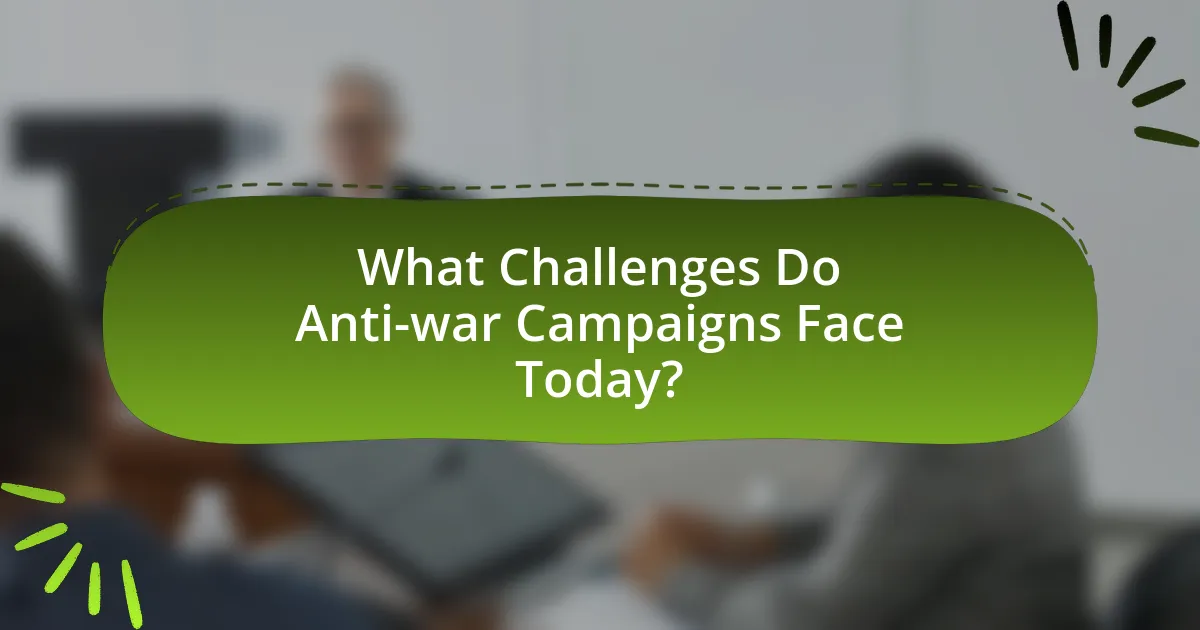
What Challenges Do Anti-war Campaigns Face Today?
Anti-war campaigns today face significant challenges, including political opposition, public apathy, and the influence of media narratives. Political opposition arises as governments often prioritize military action over diplomatic solutions, leading to a lack of support for anti-war initiatives. Public apathy is exacerbated by the normalization of conflict in media, which can desensitize individuals to the consequences of war, making them less likely to engage in activism. Additionally, the media often portrays anti-war activists as fringe or unpatriotic, undermining their credibility and outreach efforts. These factors collectively hinder the effectiveness and visibility of anti-war campaigns in contemporary society.
How has technology changed the landscape of Anti-war Campaigns?
Technology has significantly transformed the landscape of anti-war campaigns by enhancing communication, mobilization, and awareness. Social media platforms like Twitter and Facebook allow activists to disseminate information rapidly, organize protests, and engage a global audience, as evidenced by the widespread use of these platforms during the Iraq War protests in 2003, where online campaigns galvanized millions. Additionally, digital tools such as online petitions and crowdfunding have empowered grassroots movements, enabling them to gather support and resources more efficiently. The ability to share real-time updates and personal stories through blogs and videos has also humanized the impact of war, fostering empathy and solidarity among diverse groups.
What are the advantages and disadvantages of social media for these campaigns?
Social media offers significant advantages and disadvantages for anti-war campaigns. The advantages include the ability to reach a vast audience quickly, facilitating the rapid dissemination of information and mobilization of supporters. For instance, during the Arab Spring, social media platforms played a crucial role in organizing protests and spreading awareness, demonstrating their effectiveness in grassroots movements. Conversely, the disadvantages involve the potential for misinformation and the risk of backlash from opposing groups. For example, campaigns can be undermined by false narratives or targeted harassment, which can dilute their message and impact. Thus, while social media can enhance visibility and engagement for anti-war campaigns, it also presents challenges that can hinder their effectiveness.
How do online platforms affect the mobilization of supporters?
Online platforms significantly enhance the mobilization of supporters by facilitating rapid communication and information dissemination. These platforms enable organizations to reach a broader audience quickly, allowing for the organization of events, sharing of resources, and coordination of actions among supporters. For instance, during the Arab Spring, social media platforms like Twitter and Facebook played crucial roles in mobilizing protests by providing real-time updates and fostering community engagement, which led to mass gatherings and significant political change. Additionally, studies indicate that campaigns utilizing online platforms can increase participation rates by up to 50%, demonstrating their effectiveness in rallying support for causes.
What are the common obstacles faced by modern Anti-war Campaigns?
Modern anti-war campaigns commonly face obstacles such as government repression, public apathy, and misinformation. Government repression often manifests through legal restrictions on protests and surveillance of activists, which can stifle dissent and discourage participation. Public apathy is a significant barrier, as many individuals may feel disconnected from the issues or believe their actions will not lead to change, leading to low engagement levels. Misinformation, often propagated through media channels, can distort public perception of conflicts and undermine the credibility of anti-war messages. For instance, during the Iraq War, misinformation about weapons of mass destruction significantly impacted public opinion and support for military action, complicating anti-war efforts.
How do political and economic factors hinder the effectiveness of these campaigns?
Political and economic factors significantly hinder the effectiveness of anti-war campaigns by creating barriers to public engagement and resource allocation. Political factors, such as government opposition and censorship, can suppress dissenting voices and limit the dissemination of campaign messages, as seen in countries where authoritarian regimes restrict freedom of speech. Economic factors, including funding shortages and reliance on donations, can impede campaign outreach and limit the ability to mobilize supporters effectively. For instance, a lack of financial resources can restrict advertising and grassroots organizing efforts, diminishing the campaign’s visibility and impact. These combined political and economic challenges can lead to reduced public awareness and participation, ultimately undermining the campaign’s goals.
What strategies can be employed to overcome these challenges?
To overcome challenges in anti-war campaigns, grassroots mobilization and coalition-building are essential strategies. Grassroots mobilization engages communities directly, fostering local support and participation, which has been effective in campaigns like the Vietnam War protests, where widespread public demonstrations significantly influenced policy decisions. Coalition-building among diverse groups, such as peace organizations, labor unions, and civil rights activists, enhances the movement’s reach and resources, as seen in the successful anti-apartheid movement in South Africa, where unity across various sectors amplified the call for change. These strategies create a robust framework for addressing obstacles and driving impactful anti-war efforts.
What Best Practices Can Enhance the Effectiveness of Anti-war Campaigns?
Best practices that can enhance the effectiveness of anti-war campaigns include grassroots mobilization, strategic messaging, and coalition-building. Grassroots mobilization engages communities directly, fostering a sense of ownership and urgency, as seen in the Vietnam War protests where local organizations played a crucial role in rallying support. Strategic messaging ensures that the campaign resonates with diverse audiences, utilizing clear, relatable narratives that highlight the human cost of war, similar to the “Not In Our Name” campaign which effectively communicated the moral implications of military actions. Coalition-building with various stakeholders, including NGOs, faith groups, and political organizations, amplifies the campaign’s reach and credibility, as demonstrated by the global protests against the Iraq War in 2003, which united millions across different demographics. These practices collectively create a robust framework for anti-war campaigns, increasing their visibility and impact.
How can collaboration with other social movements strengthen Anti-war efforts?
Collaboration with other social movements can significantly strengthen anti-war efforts by creating a unified front that amplifies voices and resources. When diverse groups, such as environmentalists, human rights advocates, and labor organizations, join forces, they can share strategies, mobilize larger audiences, and increase visibility for anti-war messages. Historical examples, such as the Vietnam War protests, demonstrate that coalitions between anti-war activists and civil rights organizations led to greater public engagement and pressure on policymakers. Additionally, research indicates that movements that collaborate across issues can achieve higher levels of success, as seen in the 2003 global protests against the Iraq War, where various social movements united to oppose military intervention, resulting in one of the largest coordinated demonstrations in history.
What role does education and awareness play in mobilizing support for Anti-war Campaigns?
Education and awareness are crucial in mobilizing support for anti-war campaigns by informing the public about the consequences of war and promoting peace. When individuals are educated about the historical, social, and economic impacts of conflict, they are more likely to engage in activism and support initiatives aimed at preventing war. For instance, campaigns like the Vietnam War protests in the 1960s effectively utilized educational outreach to raise awareness about the war’s human costs, leading to widespread public dissent and ultimately influencing policy changes. Research indicates that informed citizens are more likely to participate in civic activities, as seen in studies by the Pew Research Center, which show a correlation between education levels and political engagement. Thus, education and awareness serve as foundational elements that empower individuals to advocate for peace and challenge militaristic policies.
